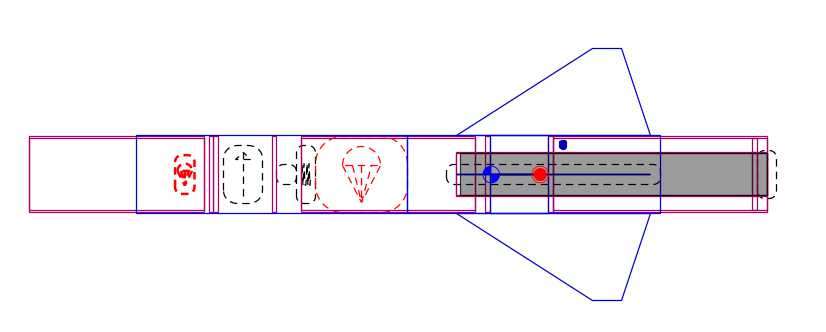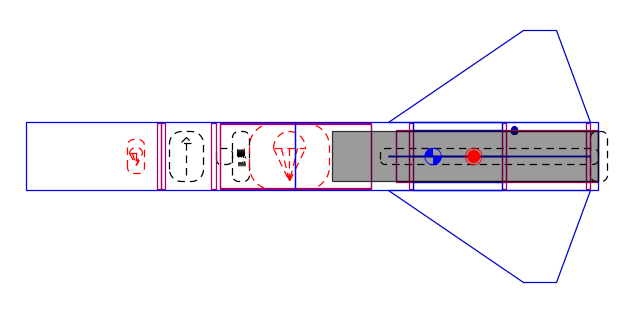Superza
New Member
I’ve been eyeing a high-powered multi-stage for a while, and after much careful designing and research I’ve settled on this rough design. The goal is to initially make a single-stage rocket, then convert it into a two-stage, and then again into a three-stage. I’m prioritizing reliability and ease of building, not overall performance (i.e. speed/altitude). I’m posting this because I am nearing the end of my designing phase, have parts, and will soon be constructing this rocket. As such, I was hoping for some constructive criticism before I make any massive mistakes. I'll also add regular updates about its progress.
The whole rocket will be 4in diameter and made of fiberglass. I have L2, so the rocket as a whole is limited to a total installed impulse of 5120Ns, and it has been designed accordingly.
Upper Stage:

Upper Stage will be 80in tall and weigh up to 17lbs fully loaded. Drogue is a 24in Crossfire. Main will be a 60in Recon. AV Bay will be held together by two 1/4in threaded rods. I have two 15ft 1/4in Tubular Kevlar Cord from my L2 that I’m planning to reuse for shock cords. The fins are 3/16in G10 Fiberglass. Undoubtedly overkill and sacrifices a ton of performance. But again, reliability first. With good fillets, these things won’t be failing anytime soon.
For its first launch, I’m thinking of either an Aerotech L1000W or an Aerotech K1050W. If it can survive a Mach 0.8-0.95 flight, then I know it will survive any of the future staged flights.
For electronics, I’ll be using the following:
Middle Stage:


After the first successful launch of the sustainer, I’ll build and add the next stage. I’m opting for dual deployment for the booster stages. The plan is an 18in parachute for the drogue that will hopefully deploy on its own out of the interstage. I also have a 50in LOC Precision parachute for main.
For motor selection, The booster will be an Aerotech K1103X. That is around 13Gs and alone can get the rocket 3000ft. For the sustainer, I’ll likely go for the J800T for the first two-stage flight, but maximum performance would be with the K250W.
The electronics will be:
Lower Stage:
View attachment 619642

Once the lower stage is added, the whole rocket will be just below 12ft tall and weigh nearly 37lbs. The lowest stage is specifically designed for the K1800. Because the rocket is getting so big and my impulse budget is running low, I’m essentially limited to just this motor. Provided my research was done correctly, it will be no lower than 11Gs off the pad and can get the fully loaded rocket up to Mach 0.4 before the next motor ignition. Recovery and electronics will probably be the same as the middle stage, depending on how two-stage recovery goes.
If anyone has concerns or feedback about the design, let me know. I’m looking forward to this project!
The whole rocket will be 4in diameter and made of fiberglass. I have L2, so the rocket as a whole is limited to a total installed impulse of 5120Ns, and it has been designed accordingly.
Upper Stage:
Upper Stage will be 80in tall and weigh up to 17lbs fully loaded. Drogue is a 24in Crossfire. Main will be a 60in Recon. AV Bay will be held together by two 1/4in threaded rods. I have two 15ft 1/4in Tubular Kevlar Cord from my L2 that I’m planning to reuse for shock cords. The fins are 3/16in G10 Fiberglass. Undoubtedly overkill and sacrifices a ton of performance. But again, reliability first. With good fillets, these things won’t be failing anytime soon.
For its first launch, I’m thinking of either an Aerotech L1000W or an Aerotech K1050W. If it can survive a Mach 0.8-0.95 flight, then I know it will survive any of the future staged flights.
For electronics, I’ll be using the following:
- EggTimer Proton for staging and secondary recovery. It will use two 2S LiPo Batteries, one for regular power and one for deployments/staging.
- Missileworks RRC2+ for primary recovery powered by a 9v battery.
- EggFinder GPS TX for GPS. It will be powered with the same 2S LiPo that powers the Proton’s regular power.
- The switches will be custom pull pin switches. The design is nearly identical to Lab Rat Rocketries, but just in case, I’ll also be adding:
- 10v 5600uF Capacitors that will run in parallel with the batteries/switches. If the switches for some reason temporarily disconnect, the capacitors will hopefully supply power for just long enough to prevent electronics from resetting.
Middle Stage:
After the first successful launch of the sustainer, I’ll build and add the next stage. I’m opting for dual deployment for the booster stages. The plan is an 18in parachute for the drogue that will hopefully deploy on its own out of the interstage. I also have a 50in LOC Precision parachute for main.
For motor selection, The booster will be an Aerotech K1103X. That is around 13Gs and alone can get the rocket 3000ft. For the sustainer, I’ll likely go for the J800T for the first two-stage flight, but maximum performance would be with the K250W.
The electronics will be:
- RRC2+ for primary recovery.
- EggTimer Quark for secondary.
- EggFinder GPS TX Mini.
- More pull pin switches and capacitors!
Lower Stage:
View attachment 619642
Once the lower stage is added, the whole rocket will be just below 12ft tall and weigh nearly 37lbs. The lowest stage is specifically designed for the K1800. Because the rocket is getting so big and my impulse budget is running low, I’m essentially limited to just this motor. Provided my research was done correctly, it will be no lower than 11Gs off the pad and can get the fully loaded rocket up to Mach 0.4 before the next motor ignition. Recovery and electronics will probably be the same as the middle stage, depending on how two-stage recovery goes.
If anyone has concerns or feedback about the design, let me know. I’m looking forward to this project!







